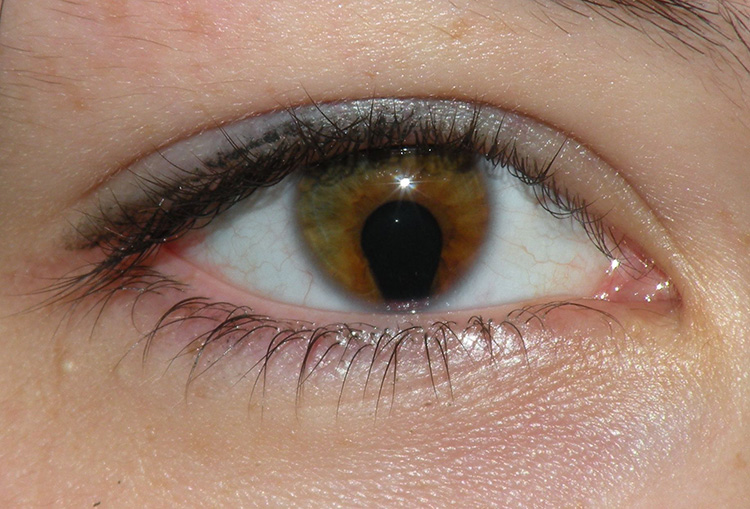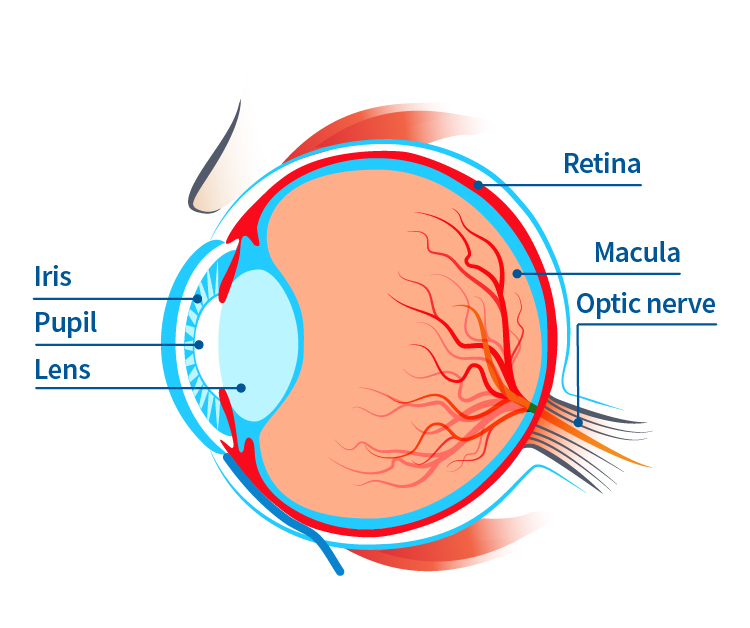What is a coloboma?
A coloboma is an area of missing tissue in your eye. Colobomas are present at birth and can affect one or both eyes. They occur when a baby’s eye tissue does not develop properly during pregnancy.
Depending on the location of the coloboma, symptoms may include unusual appearance of the eye or eyelid, blurry vision, blind spots, and sensitivity to light.
Colobomas can be inherited (passed down from parent to child) but some people with colobomas do not have any family members with the condition.
Photo Attribution: Coloboma of the Iris, by Jmarchn, made available under the Creative Commons Attribution-ShareAlike 3.0 Unported License.
A coloboma of the iris (the colored part of the eye) can cause the pupil to be unusually shaped instead of round.
Parts of the eye that can be affected by colobomas
How might a coloboma cause vision problems?
Some colobomas do not cause vision problems. Depending on the part of the eye a coloboma involves, it can cause vision problems that range from mild to severe.
Eyelid – The eyelid may not fully cover the eye, which can cause dryness and increase the risk of injury and infection.
Iris – A coloboma in the iris (the colored part of the eye) can cause sensitivity to light and blurred vision.
Lens – If the lens is small or unusually shaped, the eye may have problems focusing or develop early cataracts.
Retina – If part of the retina is missing, it can cause blind spots, especially in the upper part of a person’s vision.
Macula – If the macula is affected, the person may have decreased central vision or blind spots.
Optic Nerve – If the optic nerve is smaller than normal, moderate to severe vision loss can occur.
A person with a coloboma may have other eye conditions such as microphthalmia (abnormally small eyes) and can develop cataract or retinal detachment. Regular eye exams are necessary to maintain good eye health.
How is coloboma diagnosed?
Some colobomas are discovered at birth when a doctor examines a baby’s eyes. Other colobomas can only be seen during a dilated eye exam performed by an eye doctor.
Dilated eye exam
The eye doctor will dilate (widen) the pupils of the eyes with eye drops to allow a better view of the back of the eyes (retina and macula).
Let your eye doctor know if you or your child are having trouble seeing clearly.
How are colobomas treated?
Colobomas cannot usually be repaired, but many of the associated symptoms can be treated.
Glasses or contacts – Some people with a coloboma may need to wear corrective lenses to help them see clearly.
Patching and drops – An eye patch or eye drops may be used in the unaffected eye to prevent amblyopia (lazy eye).
Surgery – In some cases, the shape of the eyelid or pupil can be corrected with surgery.
Low vision aids – Tools and devices, such as magnifiers, large print materials, and voice-enabled devices, can help make the most of a person’s remaining vision.



